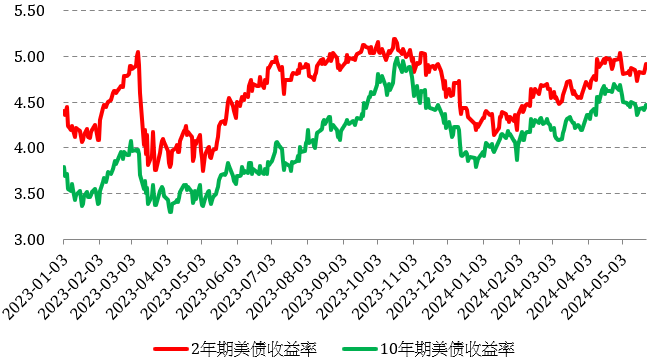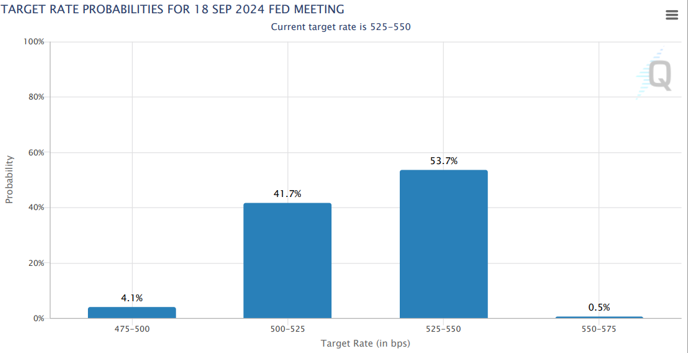Will US bond yields Hit A New High As Economy Fails To Cool
U.S. bond yields rebounded as market expectations for a Fed rate cut cooled again and indicators such as U.S. manufacturing improved in April. As of May 24, the 2-year U.S. bond yield, which is sensitive to monetary policy, rose slightly to 4.93%. It had previously climbed to 4.98% on April 18, the highest record for the year, and it was 3.89% in the same period last year; The 10-year U.S. bond yield, which reflects the outlook for U.S. economic growth, rose slightly by 4.46%. It had previously hit a record high of 4.7% this year on April 25, compared with 3.38% in the same period last year.
We believe that the short-term economic outlook of the United States is confusing. Although inflation expectations have cooled, the inflation stickiness brought about by the service industry has caused the Fed to not rush to cut interest rates. Due to factors such as technological progress such as AI, the return of manufacturing, and fiscal efforts, the impact of high interest rates on the U.S. economy is not serious yet. U.S. bond yields may maintain range fluctuations in the short to medium term, and will eventually decline in the long run.

U.S. economic indicators mixed
Judging from the recently released data, the U.S. economy is mixed, and there is no sign of entering a recession for the time being, which is one of the main reasons why the Fed is not in a hurry to cut interest rates. The improvement in performance lies in the improvement in the prosperity of the manufacturing and service industries.
According to data released by S&P Global, the Markit PMI data in the United States in May was better than expected. Among them, the manufacturing PMI hit a two-month high and broke through the 50 mark. The PMI hit a 12-month high, and the composite PMI hit a 25-month high.
With the decline in the growth rate of real disposable income, US consumption indicators have weakened significantly. According to data released by Beige Book, as of May 18, the year-on-year nominal growth rate of retail sales fell to 5.5%, after reaching 6.3% the previous week. In addition to concerns about the cost of living raised by high prices and borrowing costs, respondents in the Michigan survey also have concerns about the labor market.
Insufficient necessity for the Fed to cut interest rates in the short term
The latest meeting minutes released by the Federal Reserve FOMC showed that due to the poor inflation data in the first quarter, Fed officials are expected to wait and see for more time than they previously expected before they are more confident that inflation will fall to the target, suggesting that they are not in a hurry to cut interest rates and high interest rates. will stay longer. Several officials also expressed their willingness to further rate hike once inflation reignites.
The United States released inflation data for April. Whether it is CPI or core CPI, whether it is year-on-year or month-on-month, they have all dropped from the previous value. Although data such as CPI suggest that inflation is returning to a downward trend, the Fed wants to see more and more precise data. Fed Chairman Jay Powell said on May 14 that patience will be needed to let restrictive policies work, with some officials expecting no rate cuts at all this year.

The US dollar financial environment is still relatively loose, and the Fed believes that there is no need to cut interest rates in the current loose liquidity environment. Judging from the Chicago Fed's financial conditions index, the negative value of the index continues to expand, indicating that the degree of financial easing has increased. As of May 17, the Chicago Fed's financial conditions index was-0.56, which rose to-0.47 in April.
The depletion of the Fed's overnight reverse repurchase liquidity that the market was worried about has not yet appeared, and the urgency of cutting interest rates is not enough.
High interest rates are unsustainable in the long run
From the perspective of neutral interest rate, the current US dollar interest rate exceeds the neutral interest rate, the output gap is almost zero, and the US real estate market and household consumption are suppressed by high interest rates. The reason why the Fed is not in a hurry to cut interest rates is that the rate of inflation decline is still weaker than expected, and factors such as US fiscal expenditures and capital expenditures have hedged part of the impact or delayed impact of high interest rates. From the perspective of debt sustainability, US fiscal expansion is unsustainable, which means that US dollar interest rates will eventually drop significantly in the fourth quarter.
To sum up, the U.S. economic indicators are mixed, and there is no sign of entering a recession for the time being. Coupled with the policy target of inflation rebounding or falling back to 2% for a long time, the Fed is not in a hurry to cut interest rates. With repeated interest rate cut expectations, US dollar interest rates have fallen into range fluctuations in the short term. In the long run, high interest rates are unsustainable. Investors can use CME group yield futures to hedge against the fluctuation risk of US dollar interest rates rising first and then falling
$NQ100 Index Main 2406 (NQmain) $$SP500 Index Main 2406 (ESmain) $$Dow Jones Main 2406 (YMmain) $$Gold Master 2408 (GCmain) $$WTI Crude Oil Main Company 2407 (CLmain) $
Disclaimer: Investing carries risk. This is not financial advice. The above content should not be regarded as an offer, recommendation, or solicitation on acquiring or disposing of any financial products, any associated discussions, comments, or posts by author or other users should not be considered as such either. It is solely for general information purpose only, which does not consider your own investment objectives, financial situations or needs. TTM assumes no responsibility or warranty for the accuracy and completeness of the information, investors should do their own research and may seek professional advice before investing.
- buythedip·05-30🙏 Very informative and helpful for investors!LikeReport
- twizzy·05-30🙏🏼LikeReport
